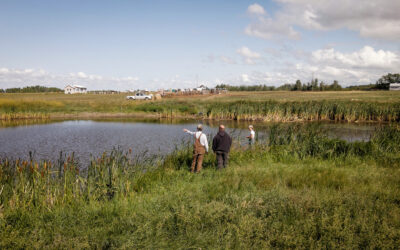Restoring marginal or unproductive agricultural land to new acres of nature can help achieve Canada’s 2030 Nature Strategy. Recognizing that nature conservation happens on agricultural lands is the first step toward making these acres count.
ALUS applauds the federal government on its release of Canada’s 2030 Nature Strategy and welcomes recognition that many existing initiatives, like ALUS, are already in place to help achieve Canada’s ambitious commitments under the Kunming-Montréal Global Biodiversity Framework.
Canada’s 2030 Nature Strategy acknowledges the ALUS program as one of the promising and successful tools advancing biodiversity outcomes on the working landscape. However, strategic recommendations and actions to support farm-based conservation activities remain largely absent in the Strategy itself.
It’s anticipated that recommendations will appear in the forthcoming Sustainable Agriculture Strategy, but this creates a rigid distinction between environmental and agricultural activity that fails to recognize that conservation action can and does take place on agricultural land. Removing this distinction opens up the tremendous nature restoration opportunity marginal agricultural lands provide and its ability to contribute to Canada’s goals to halt and reverse biodiversity loss.
At a Glance: How ALUS delivers on the 2030 Nature Strategy
- Adds additional & permanent acres of nature
- Creates habitat for species at risk
- Delivers sustainable market-based incentives
- Adds natural infrastructure to the rural landscape
- Fosters knowledge transfer & peer-to-peer learning
- Leads ecosystem service quantification research
- Drives private and philanthropic investment in nature
- Applies a whole-of-society approach to nature-based solutions
Seizing the Opportunity
ALUS’ mission is to seize this opportunity—to restore marginal and unproductive agricultural land into new acres of nature that generate benefits for people and communities. Our work takes place on agricultural land, but it’s environmental in nature.
We’ve built a proven and effective farmer-focused program and market-based mechanism that engages farmers and ranchers in establishing, managing and stewarding new acres of nature, like wetlands, grasslands and forests, on marginal agricultural lands. These projects help solve the triple crises of biodiversity loss, climate change and pollution by creating new habitat, sequestering carbon and reducing nutrient run-off.
ALUS relies on trust-based relationships with farmers and public, private and philanthropic investment to deliver the ALUS program. Our non-prescriptive program model, underpinned by market-based mechanisms, was purpose-built to deliver shared value to farmers, communities and investors.

Community-based program delivery helps rural communities design solutions that work for farmers and address local environmental problems.

Project cost-sharing and annual payments de-risk practice adoption and land management change for farmers and ranchers.

Regional, tangible projects delivered by real people attract private and philanthropic investment in nature-based solutions.
Building on ALUS’ Success
ALUS works on agricultural lands, but we’re building natural solutions to biodiversity loss, climate change and pollution. ALUS operates uniquely in the space where agriculture and nature meet to produce environmental outcomes that can help Canada deliver on several of the Nature Strategy’s goals and objectives by doing the following:
- Adding additional and permanent acres of nature to the working landscape through marginal land restoration projects, which have a proven low conversion rate back to cropland.
- Providing habitat specifically targeted to support species at risk.
- Offering sustainable, ongoing market-based incentives to farmers and ranchers to engage in long-term conservation action.
- Ensuring projects are actively monitored and maintained to ensure high ecosystem function, including invasive species control and removal.
- Increasing natural infrastructure in rural communities to mitigate the effects of climate change, sequester carbon, and build resilience to severe weather events like flood, drought and wildfire.
- Engaging stakeholders across various levels of government, industry sectors and community organizations to deliver a whole-of-society approach.
- Supporting the socio-economic development of rural communities through knowledge transfer and job creation.
- Leading in innovative ecosystem service quantification research to measure outcomes and support the accurate valuation of nature.
- Driving private and philanthropic investment in nature restoration through ALUS’ market-facing suite of nature and climate solutions.
There are nearly 190,000 farms in Canada, covering approximately 6.2% of Canada’s land area. The opportunity to restore marginal land into new acres of nature on these farms is potentially significant.
ALUS is poised to support Canada in delivering solutions to biodiversity loss and climate change across the country. Recognizing that marginal and unproductive agricultural land restoration projects are fundamentally environmental in nature and contribute to Canada’s natural asset inventory will ensure the tens of thousands of acres restored by ALUS farmers and ranchers count towards Canada’s ambitious goals to halt and reverse biodiversity loss and restore 30% of Canada’s land and water resources by 2030.




